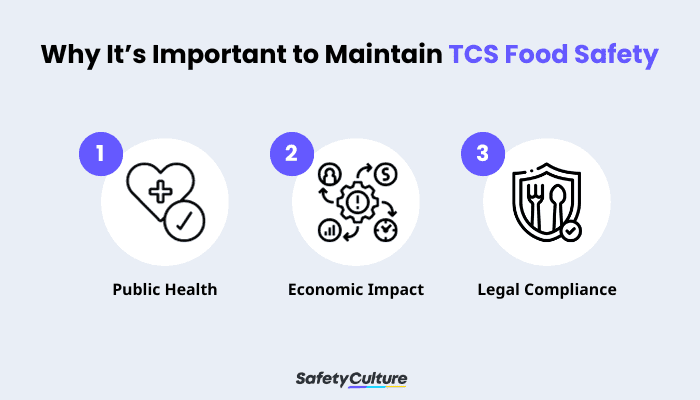What is TCS Food?
TCS food refers to a category of perishable food items that require specific time and temperature controls to ensure they are safe to eat. TCS foods are also sometimes known as Potentially Hazardous Foods or PHF because they are more susceptible to bacterial growth and foodborne illnesses if not handled and stored correctly. Hence, organizations handling and preparing TCS food and individuals in the food manufacturing and safety industry must enforce stringent protocols at all times to ensure safe human consumption.
Why It’s Important to Maintain TCS Food Safety
An estimated 1.3 billion tons of edible food is lost and wasted yearly, according to the Food and Agricultural Organization (FAO), as cited by the US National Center for Biotechnology Information (NCBI). This is often due to foods that have been spoiled, among other reasons such as oversupply.
In general, food safety must be upheld and maintained by food manufacturers, processors, distributors, and other supply chain stakeholders. Particularly for TCS food, specific safety practices must be implemented to preserve their quality without compromising the health of those who will consume it.
Further, the following are the other factors to consider on why it’s crucial to implement TCS food safety practices:

Why It’s Important to Maintain TCS Food Safety
Public Health
TCS foods are more prone to bacterial growth, which can lead to foodborne illnesses if not handled and stored properly. Consuming contaminated TCS foods can result in illnesses, such as salmonellosis and other bacterial infections.
Foodborne illnesses can then lead to outbreaks that affect many people, causing serious health risks and potential fatalities. Hence, maintaining TCS food safety is vital in protecting public health and reducing the burden on healthcare systems.
Economic Impact
Foodborne illness outbreaks caused by consuming contaminated TCS foods can have a significant economic impact on businesses and the food industry as a whole. Recalls, lawsuits, and decreased customer confidence can lead to financial losses for companies.
On the other hand, ensuring the safety of TCS foods is a fundamental aspect of providing high-quality food service. Customers expect safe and wholesome meals when dining out or purchasing food products, and meeting these expectations is essential for customer satisfaction and loyalty. This can have a direct and indirect impact on their willingness to purchase food and snowball into significant economic implications.
Legal Compliance
It’s helpful to remember that many countries and regions have strict food safety standards and regulations in place, including Good Manufacturing Practices (GMP) in the food industry. Failure to adhere to these can result in legal consequences, including fines and the closure of food establishments.
Properly handling and storing TCS foods can extend their shelf life, reducing the amount of food that goes to waste. This is not only economically beneficial, but also environmentally responsible and helps businesses comply with regulatory requirements related to conscious and sustainable food production efforts.
Create Your Own Food Safety Checklist
Eliminate manual tasks and streamline your operations.
Get started for FREECharacteristics of TCS Food
To help organizations identify what foods are considered TCS and determine the most appropriate food safety practices, here are some factors and characteristics to pay attention to:
Acidity
Foods with low acidity, such as meats and dairy products, are more susceptible to bacterial growth if not properly handled and stored. In contrast, acidic foods like citrus fruits or tomatoes may inhibit the growth of certain pathogens due to their lower pH levels.
Moisture Content
Moisture content is another critical factor in TCS food safety. Foods with high moisture content, such as fresh fruits and vegetables, seafood, and cooked grains, provide an ideal environment for bacterial growth. Hence, controlling moisture levels, particularly through proper refrigeration and storage, is essential for preventing spoilage and foodborne illnesses.
Acidity and Moisture Interaction
The interaction between acidity and moisture content can influence the growth of microorganisms. For example, combining acidic ingredients with low moisture content, like pickled vegetables, can create an inhospitable environment for many bacteria, making the food safer to consume.
Heat Treatment
Cooking TCS foods to specific internal temperatures kills harmful pathogens like bacteria and parasites, making the food safe for consumption. Heat treatment also helps extend the shelf life of certain foods, such as canned goods.
Packaging
The type of packaging used for TCS foods can impact their safety. Airtight and vacuum-sealed packaging can help prevent the entry of oxygen and spoilage microorganisms, thus extending the shelf life of TCS foods. This also avoids cross-contamination during storage and transportation.
Examples
Some of the most common TCS food examples include the following:
- Meat products (beef, pork, lamb, chicken, turkey, duck, and ground meat)
- Seafood (salmon, tilapia, tuna, shrimp, crab, oysters, canned seafood)
- Dairy products (milk, cheese, yogurt, cream, sour cream)
- Eggs and egg products
- Poultry products
- Cooked rice and pasta
- Tofu and other soy products
- Sliced melons (watermelon, cantaloupe, honeydew)
- Sliced or diced tomatoes (unless they’re canned with proper processing)
- Cut leafy greens (lettuce, spinach, kale)
- Sprouts and sprout seeds (alfalfa, bean, broccoli sprouts)
- Foods containing TCS ingredients (sandwiches, salads)
How to Keep TCS Food Safe
It’s crucial for food service establishments and individuals preparing food to follow food safety guidelines when dealing with TCS foods to reduce the risk of foodborne illnesses and prevent the growth of harmful bacteria. Several key practices and strategies to achieve these include the following:
Time Control
The “2-Hour Rule” suggests that TCS foods should not be left out of refrigeration for more than two hours. However, if the ambient temperature is above 90°F (32°C), the limit decreases to one hour.
Also, make sure to label TCS foods with the date and time they were prepared or opened to track their freshness and ensure that they’re used within safe timeframes.
Another control measure is that when storing TCS foods in a commercial kitchen or at home, practice the FIFO (First-In, First-Out) method to use the oldest items first. This approach prevents older items from sitting too long and potentially becoming unsafe to consume.
Temperature Control
Generally, the temperature danger zone is between 41℉ (5°C) and 135℉ (~57°C)—a temperature range in which pathogens grow well. Hence, you must follow the recommended storage temperature, such as the following:
- Store TCS foods in a refrigerator at or below 40°F (4°C).
- If you won’t use TCS foods within a few days, consider freezing them at a temperature of 0°F (-18°C) or lower to prolong their shelf life.
For cooking, make sure to reach the recommended internal temperatures to kill harmful pathogens. For example:
- Poultry: 165°F (74°C)
- Ground meat: 160°F (71°C)
- Fish: 145°F (63°C)
To help you effectively monitor and maintain these minimum safe temperatures for TCS food handling and preparation, you must leverage remote temperature monitoring systems with the functionality of IoT Sensors from SafetyCulture (formerly iAuditor). This way, you can set triggered, real-time alerts on out-of-range temperatures and never miss food safety incidents.
Explore SafetyCulture Monitoring Solution
Utilize advanced sensor technology to monitor assets, automate vital alerts, implement actions, and report urgent issues.
Talk to an expertSafe Thawing
Thaw frozen TCS foods in the refrigerator at or below 40°F (4°C) or place it in a sealed, leak-proof plastic bag and submerge it in cold water f you need it to thaw quickly. Make sure to cook the food immediately after thawing.
Proper Food Storage
A helpful tip is to arrange foods in the refrigerator, freezer, and pantry so that TCS items are stored separately from non-TCS items and raw ingredients. Remember to store TCS foods in airtight containers or wrap them tightly to prevent exposure to air and moisture, which can lead to spoilage.
Hygiene and Sanitation
Ensure that food handlers maintain good personal and food hygiene. Also, make sure to maintain clean surfaces, utensils, and equipment through regular sanitation to prevent the buildup of harmful bacteria and avoid cross-contamination.
Training
Maintaining TCS food safety requires employees to be well-trained in food handling and safety practices. This not only ensures the safety of the food but also contributes to the development of a skilled and responsible workforce.




